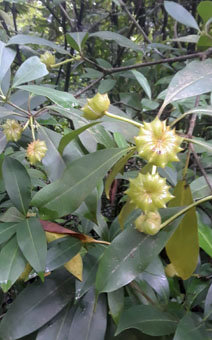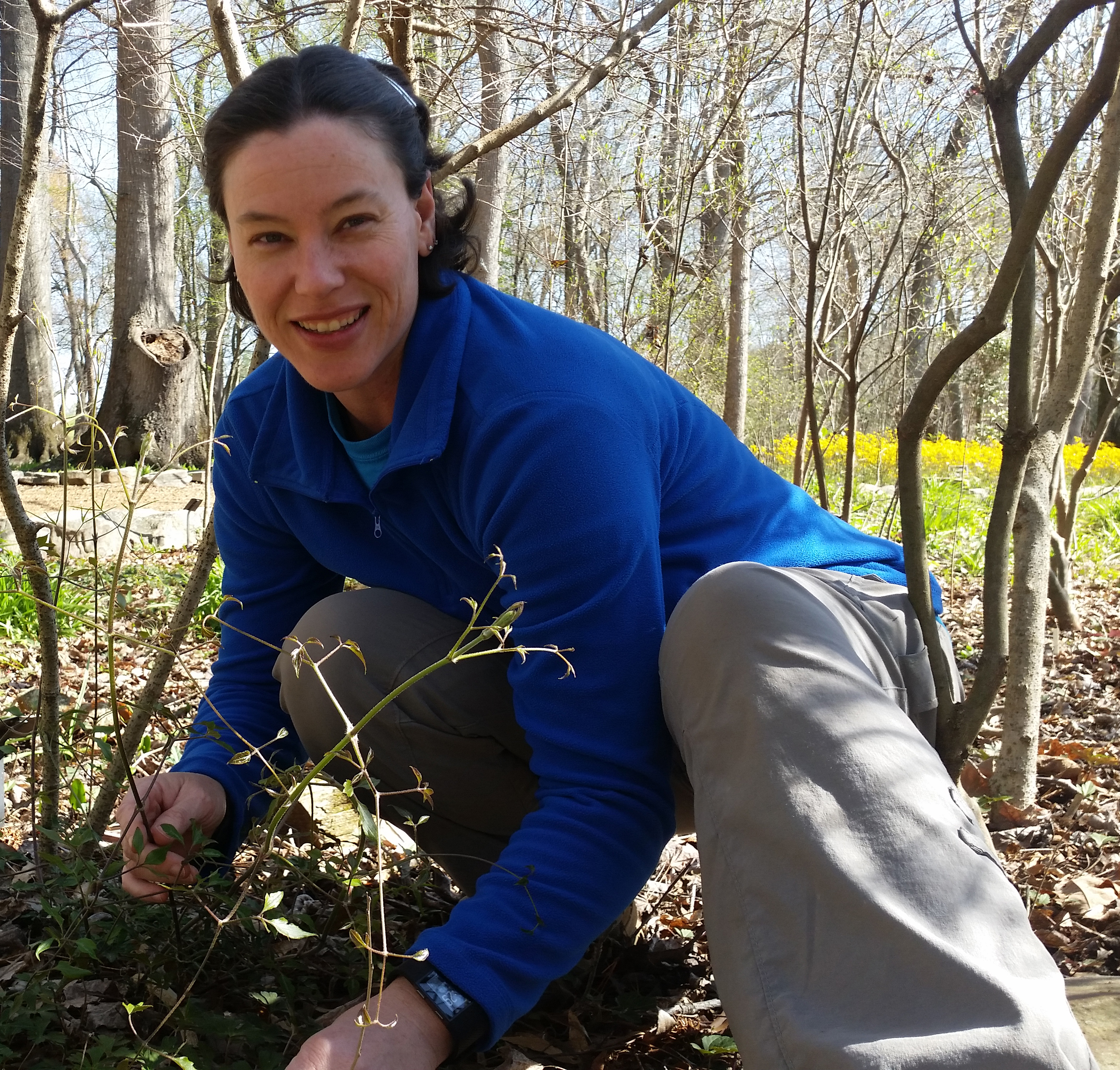Don’t let the rain get you down -this month we are featuring a few plants that like it wet! Come to the Garden to see these shade-loving beauties in person!

Clethra alnifolia, commonly known as Summersweet or, is a deciduous shrub that is native to swampy woodlands, wet marshes, and stream banks in eastern North America. This member of Clethraceae (the Clethra family) is a rounded, densely-branched, woody shrub that typically grows to 3-6 feet tall and forms colonies via root suckers. It produces showy, sweetly fragrant white flowers which appear in narrow, upright panicles (2-6 inch long racemes) July to August. ‘Ruby Spice’ is a cultivated variety noted for its fragrant rose-pink flowers that bloom in late summer. It was discovered in 1992 as a sport of Clethra alnifolia ‘Pink Spire’. The flowers (white or pink) are very attractive to butterflies and bees. Glossy dark green leaves turn attractive shades of yellow to golden brown in the fall. This low maintenance shrub is easily grown in average, medium to wet soils in full sun to part shade with consistently moist, acidic soils. It tolerates heavy shade, clay soil, wet soil, and reduces erosion. If a naturalized look is not desired, root suckers can be removed without harm to the plant. It has no serious insect or disease problems and pruning is rarely needed. Sweet Pepperbush is a great problem-solver because of its ability to bloom in shady locations in late summer when few other shrubs are in bloom, and it thrives in troublesome boggy areas. It excels in cottage gardens, wild gardens or naturalized areas and its compact size makes it ideal for smaller gardens.

Hymenocallis occidentalis, commonly called White Spider Lily, is an herbaceous perennial bulb that occurs in swamps and moist woods. This member of Amaryllidaceae (the Amaryllis family) is native to the southeastern United States and looks like a spidery daffodil. Five to ten fragrant, white, spidery flowers (to 6 inches across) are held on an 18-22 inch stalk that emerges from the center of the strap-shaped, amaryllis-like foliage (each leaf gets up to 17 inches long) in August. This low maintenance plant is best grown in medium to wet soils in full sun to part shade, and has no serious insect or disease problems. It should never be dug up for transplanting to a home garden from the wild because they are somewhat rare. Chose cultivated bulbs from reputable nurseries instead. Synonymous with and sometimes sold as Hymenocallis caroliniana. Best used in moist open woodland gardens, bog gardens or along streams and ponds. May also be grown in a border as long as the soil moisture requirements can be met – never let it dry out.

Rudbeckia laciniata, commonly known as Cutleaf Coneflower, is a herbaceous perennial which occurs in moist soils in woodlands, thickets, and along streams in North America. Also known as Tall Coneflower, it may grow to 9 feet tall in the wild, but typically only grows 3-4 feet tall and 1-3 feet wide in cultivation. This member of Asteraceae (Aster family) features long-blooming daisy-like flowers up to 3.5 inches across with drooping yellow rays and dome-like, green center disks. The foliage is striking – bold, pinnate, and deeply lobed light green leaves make a statement even before flowering July to September. Easily grown in average, medium, well-drained soil in full sun to part shade. Tolerates deer browse and hot and humid summers while attracting butterflies with its showy flowers. Great for naturalizing, it can colonize if conditions are favorable. Deadheading will encourage a fall re-bloom. No serious insect or disease problems. Taller plants may need support.

Onoclea sensibilis, commonly known as Sensitive Fern, is a large, coarse, deciduous fern that occurs in wet woods and thickets and in moist soils along streams and springs in eastern North America. This member of Onocleaceae (a small family of terrestrial ferns) grows up to 4 feet tall and wide. While it has no true flowers, it features long-stalked, deeply pinnatifid, bright green, vegetative (sterile) fronds with leathery, triangular leaflets (pinnae) which have distinctively netted veins. Shorter, erect, woody (fertile) fronds (to 12 inches tall) covered in brown bead-like segments emerge in late summer and persist through winter. The combination makes for a striking foliage plant for shady, moist borders. It is resistant to rabbit browse and tolerates heavy shade, clay soil, wet soil, and Black Walnut. It is called Sensitive Fern because the green vegetative fronds suffer almost immediate damage from the first fall frost. Sensitive fern has no serious insect or disease problems, but it is intolerant of drought. Best grown in wet woodland gardens and moist locations along streams and ponds and shaded areas where it can naturalize.

Illicium floridanum, commonly known as purple anise, is an upright, rounded, aromatic, evergreen shrub that grows to 6-10 feet by 4-8 feet tall. Purple anise is a member of Schisandraceae, a family of three genera and approximately 90 species of flowering plants that consist of mostly tropical and subtropical woody plants that are primarily pollinated by beetles. Purple anise is native to wet soils in marshy areas, low wooded ravines, and stream banks in the southeastern United States and northern Mexico. Smooth, glossy dark olive-green leaves emit an anise-like aroma when crushed. While the dark red flowers with strap-shaped petals bloom April-May, the fruit is the star in August. The attractive and unusual fruit is literally a starburst-shaped cluster of follicles that split open when dry to release the seeds. Best grown in part- to full shade in medium to wet soils. This is a great problem-solver for landscapes with heavy shade, erosion, and/or wet soil. It tolerates full sun as long as soils are kept uniformly moist, has no serious insect or disease problems, and makes an excellent care-free evergreen shrub for moist shady locations. Purple anise will colonize by root suckers if conditions are favorable. Purple anise is widely available in nurseries as both the species and cultivated varieties, but wild populations are protected in Florida as a threatened species.

Malvaviscus arboreusvar. drummondii, commonly known as Turk’s Cap, is native to the Southeastern United States, Mexico, Central America, and South America. This member of Malvaceae (mallow family) typically grows as a coarse deciduous shrub that reaches 3-6 feet tall and wide. Turk’s Cap is more common in south Alabama in light shade near streams. Showy red flowers bloom in the leaf axils on short stalks July – Sept (depending on weather and geographic position). The overlapping petals are fused with the calyx for 2/3rds of its length, making it appear as though it is never fully “open”, giving it a unique twisted shape. Turk’s Cap Mallow is widely available from nurseries and prefers a site with full to partial sun and well-draining soil. It is drought tolerant, deer resistant, and attracts large numbers of butterflies and hummingbirds. Close relatives include okra and cotton along with numerous genera that include herbs, shrubs, and small trees in tropical South America.

